Hyundai Santa Fe 2019 Owner's Manual - RHD (UK, Australia)
Manufacturer: HYUNDAI, Model Year: 2019, Model line: Santa Fe, Model: Hyundai Santa Fe 2019Pages: 682, PDF Size: 16.24 MB
Page 391 of 682
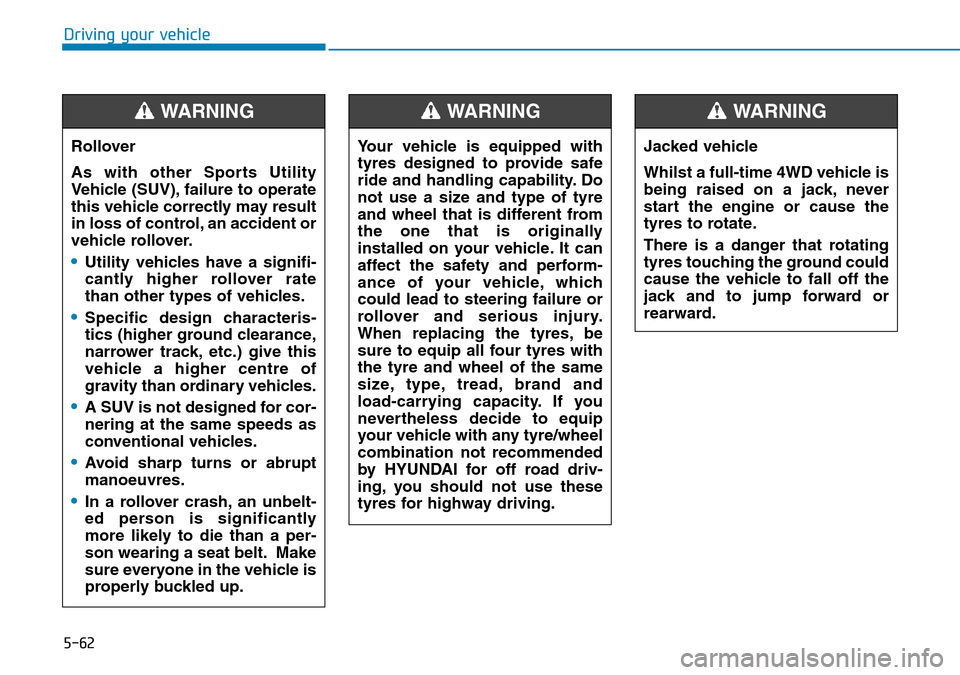
5-62
Driving your vehicle
Rollover
As with other Sports Utility
Vehicle (SUV), failure to operate
this vehicle correctly may result
in loss of control, an accident or
vehicle rollover.
•Utility vehicles have a signifi-
cantly higher rollover rate
than other types of vehicles.
•Specific design characteris-
tics (higher ground clearance,
narrower track, etc.) give this
vehicle a higher centre of
gravity than ordinary vehicles.
•A SUV is not designed for cor-
nering at the same speeds as
conventional vehicles.
•Avoid sharp turns or abrupt
manoeuvres.
•In a rollover crash, an unbelt-
ed person is significantly
more likely to die than a per-
son wearing a seat belt. Make
sure everyone in the vehicle is
properly buckled up.
WARNING
Your vehicle is equipped with
tyres designed to provide safe
ride and handling capability. Do
not use a size and type of tyre
and wheel that is different from
the one that is originally
installed on your vehicle. It can
affect the safety and perform-
ance of your vehicle, which
could lead to steering failure or
rollover and serious injury.
When replacing the tyres, be
sure to equip all four tyres with
the tyre and wheel of the same
size, type, tread, brand and
load-carrying capacity. If you
nevertheless decide to equip
your vehicle with any tyre/wheel
combination not recommended
by HYUNDAI for off road driv-
ing, you should not use these
tyres for highway driving.
WARNING
Jacked vehicle
Whilst a full-time 4WD vehicle is
being raised on a jack, never
start the engine or cause the
tyres to rotate.
There is a danger that rotating
tyres touching the ground could
cause the vehicle to fall off the
jack and to jump forward or
rearward.
WARNING
Page 392 of 682
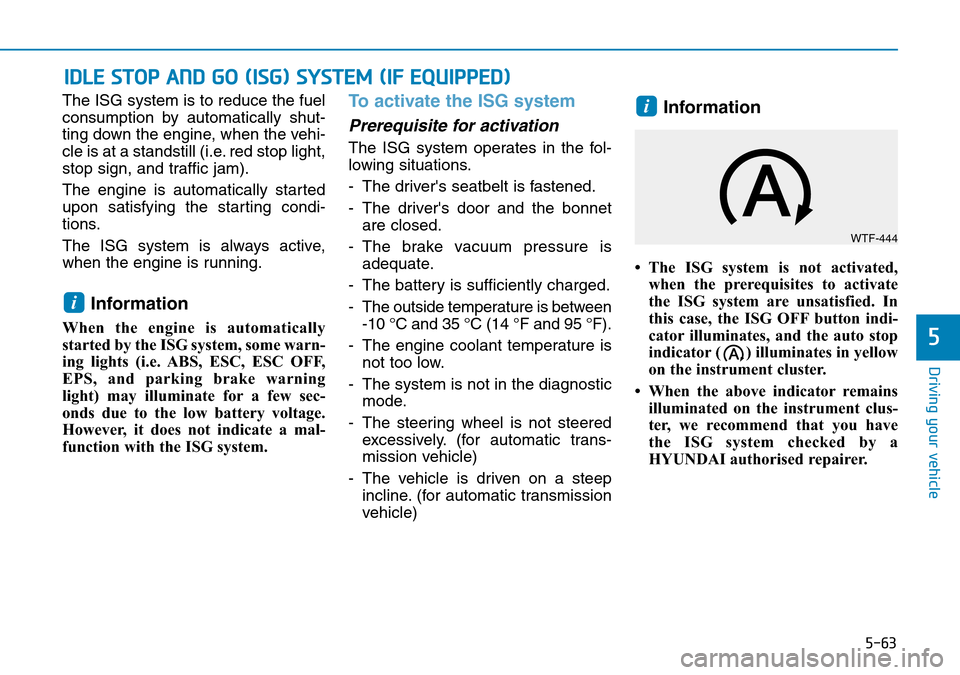
5-63
Driving your vehicle
5
The ISG system is to reduce the fuel
consumption by automatically shut-
ting down the engine, when the vehi-
cle is at a standstill (i.e. red stop light,
stop sign, and traffic jam).
The engine is automatically started
upon satisfying the starting condi-
tions.
The ISG system is always active,
when the engine is running.
Information
When the engine is automatically
started by the ISG system, some warn-
ing lights (i.e. ABS, ESC, ESC OFF,
EPS, and parking brake warning
light) may illuminate for a few sec-
onds due to the low battery voltage.
However, it does not indicate a mal-
function with the ISG system.
To activate the ISG system
Prerequisite for activation
The ISG system operates in the fol-
lowing situations.
- The driver's seatbelt is fastened.
- The driver's door and the bonnet
are closed.
- The brake vacuum pressure is
adequate.
- The battery is sufficiently charged.
- The outside temperature is between
-10 °C and 35 °C (14 °F and 95 °F).
- The engine coolant temperature is
not too low.
- The system is not in the diagnostic
mode.
- The steering wheel is not steered
excessively. (for automatic trans-
mission vehicle)
- The vehicle is driven on a steep
incline. (for automatic transmission
vehicle)
Information
• The ISG system is not activated,
when the prerequisites to activate
the ISG system are unsatisfied. In
this case, the ISG OFF button indi-
cator illuminates, and the auto stop
indicator ( ) illuminates in yellow
on the instrument cluster.
• When the above indicator remains
illuminated on the instrument clus-
ter, we recommend that you have
the ISG system checked by a
HYUNDAI authorised repairer.
i
i
IDLE STOP AND GO (ISG) SYSTEM (IF EQUIPPED)
WTF-444
Page 393 of 682
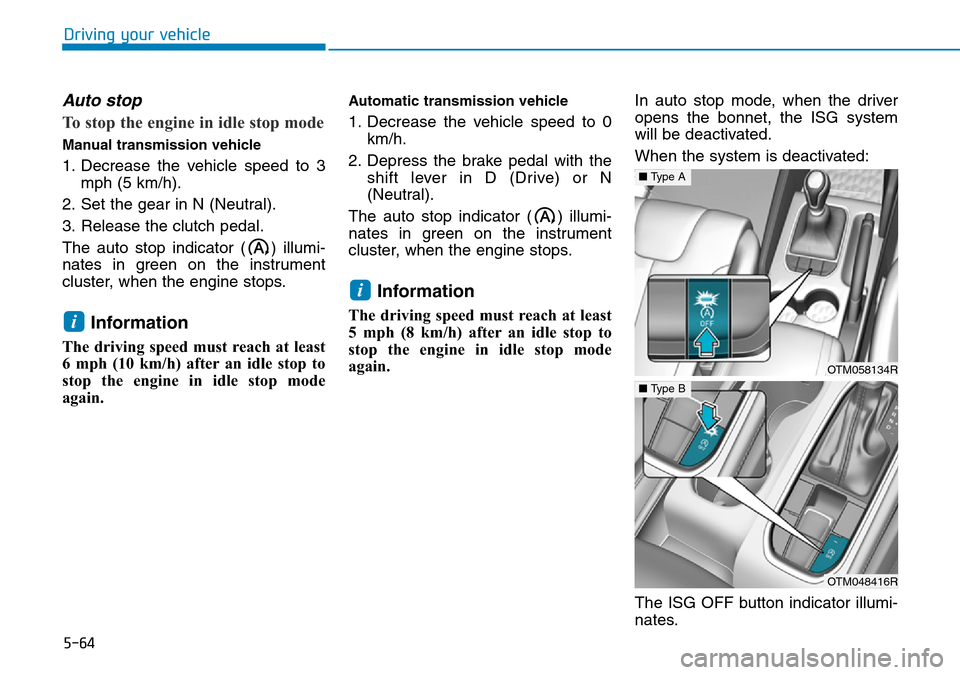
5-64
Driving your vehicle
Auto stop
To stop the engine in idle stop mode
Manual transmission vehicle
1. Decrease the vehicle speed to 3
mph (5 km/h).
2. Set the gear in N (Neutral).
3. Release the clutch pedal.
The auto stop indicator ( ) illumi-
nates in green on the instrument
cluster, when the engine stops.
Information
The driving speed must reach at least
6 mph (10 km/h) after an idle stop to
stop the engine in idle stop mode
again.
Automatic transmission vehicle
1. Decrease the vehicle speed to 0
km/h.
2. Depress the brake pedal with the
shift lever in D (Drive) or N
(Neutral).
The auto stop indicator ( ) illumi-
nates in green on the instrument
cluster, when the engine stops.
Information
The driving speed must reach at least
5 mph (8 km/h) after an idle stop to
stop the engine in idle stop mode
again.In auto stop mode, when the driver
opens the bonnet, the ISG system
will be deactivated.
When the system is deactivated:
The ISG OFF button indicator illumi-
nates.
i
i
OTM058134R
■Type A
OTM048416R
■Type B
Page 394 of 682
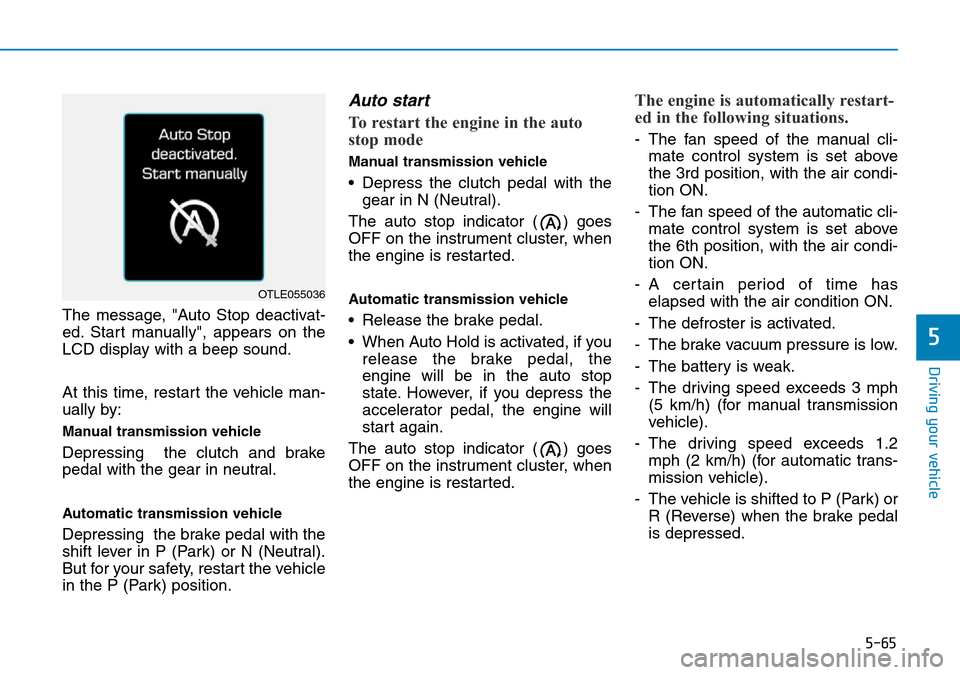
5-65
Driving your vehicle
5
The message, "Auto Stop deactivat-
ed. Start manually", appears on the
LCD display with a beep sound.
At this time, restart the vehicle man-
ually by:
Manual transmission vehicle
Depressing the clutch and brake
pedal with the gear in neutral.
Automatic transmission vehicle
Depressing the brake pedal with the
shift lever in P (Park) or N (Neutral).
But for your safety, restart the vehicle
in the P (Park) position.
Auto start
To restart the engine in the auto
stop mode
Manual transmission vehicle
• Depress the clutch pedal with the
gear in N (Neutral).
The auto stop indicator ( ) goes
OFF on the instrument cluster, when
the engine is restarted.
Automatic transmission vehicle
• Release the brake pedal.
• When Auto Hold is activated, if you
release the brake pedal, the
engine will be in the auto stop
state. However, if you depress the
accelerator pedal, the engine will
start again.
The auto stop indicator ( ) goes
OFF on the instrument cluster, when
the engine is restarted.
The engine is automatically restart-
ed in the following situations.
- The fan speed of the manual cli-
mate control system is set above
the 3rd position, with the air condi-
tion ON.
- The fan speed of the automatic cli-
mate control system is set above
the 6th position, with the air condi-
tion ON.
- A certain period of time has
elapsed with the air condition ON.
- The defroster is activated.
- The brake vacuum pressure is low.
- The battery is weak.
- The driving speed exceeds 3 mph
(5 km/h) (for manual transmission
vehicle).
- The driving speed exceeds 1.2
mph (2 km/h) (for automatic trans-
mission vehicle).
- The vehicle is shifted to P (Park) or
R (Reverse) when the brake pedal
is depressed.
OTLE055036
Page 395 of 682
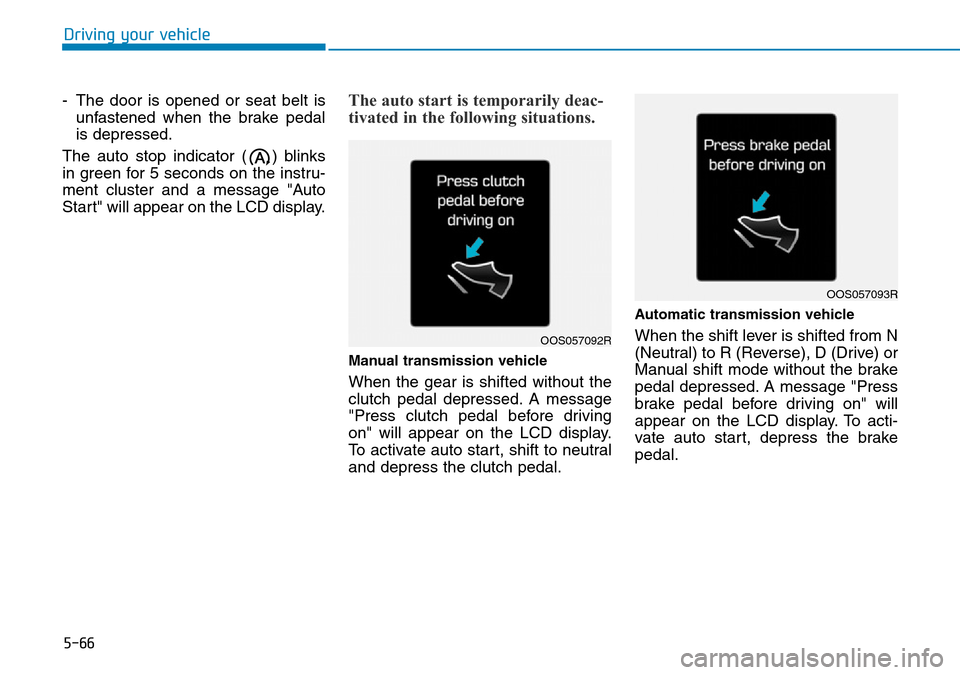
5-66
Driving your vehicle
- The door is opened or seat belt is
unfastened when the brake pedal
is depressed.
The auto stop indicator ( ) blinks
in green for 5 seconds on the instru-
ment cluster and a message "Auto
Start" will appear on the LCD display.
The auto start is temporarily deac-
tivated in the following situations.
Manual transmission vehicle
When the gear is shifted without the
clutch pedal depressed. A message
"Press clutch pedal before driving
on" will appear on the LCD display.
To activate auto start, shift to neutral
and depress the clutch pedal.
Automatic transmission vehicle
When the shift lever is shifted from N
(Neutral) to R (Reverse), D (Drive) or
Manual shift mode without the brake
pedal depressed. A message "Press
brake pedal before driving on" will
appear on the LCD display. To acti-
vate auto start, depress the brake
pedal.OOS057092R
OOS057093R
Page 396 of 682
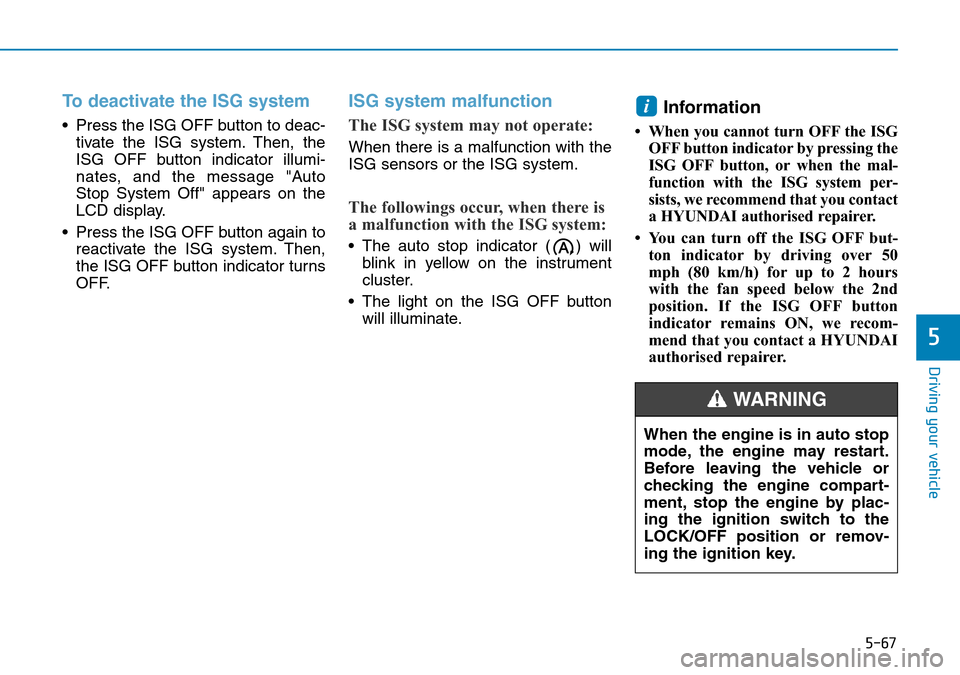
5-67
Driving your vehicle
5
To deactivate the ISG system
• Press the ISG OFF button to deac-
tivate the ISG system. Then, the
ISG OFF button indicator illumi-
nates, and the message "Auto
Stop System Off" appears on the
LCD display.
• Press the ISG OFF button again to
reactivate the ISG system. Then,
the ISG OFF button indicator turns
OFF.
ISG system malfunction
The ISG system may not operate:
When there is a malfunction with the
ISG sensors or the ISG system.
The followings occur, when there is
a malfunction with the ISG system:
• The auto stop indicator ( ) will
blink in yellow on the instrument
cluster.
• The light on the ISG OFF button
will illuminate.
Information
• When you cannot turn OFF the ISG
OFF button indicator by pressing the
ISG OFF button, or when the mal-
function with the ISG system per-
sists, we recommend that you contact
a HYUNDAI authorised repairer.
• You can turn off the ISG OFF but-
ton indicator by driving over 50
mph (80 km/h) for up to 2 hours
with the fan speed below the 2nd
position. If the ISG OFF button
indicator remains ON, we recom-
mend that you contact a HYUNDAI
authorised repairer.
i
When the engine is in auto stop
mode, the engine may restart.
Before leaving the vehicle or
checking the engine compart-
ment, stop the engine by plac-
ing the ignition switch to the
LOCK/OFF position or remov-
ing the ignition key.
WARNING
Page 397 of 682
![Hyundai Santa Fe 2019 Owners Manual - RHD (UK, Australia) 5-68
Driving your vehicle
The battery sensor deactiva-
tion
[A] : Battery sensor
The battery sensor is deactivated,
when the battery is disconnected
from the negative pole for mainte-
nance purpose.
I Hyundai Santa Fe 2019 Owners Manual - RHD (UK, Australia) 5-68
Driving your vehicle
The battery sensor deactiva-
tion
[A] : Battery sensor
The battery sensor is deactivated,
when the battery is disconnected
from the negative pole for mainte-
nance purpose.
I](/img/35/16317/w960_16317-396.png)
5-68
Driving your vehicle
The battery sensor deactiva-
tion
[A] : Battery sensor
The battery sensor is deactivated,
when the battery is disconnected
from the negative pole for mainte-
nance purpose.
In this case, the ISG system is limit-
edly operated due to the battery sen-
sor deactivation. Thus, the driver
needs to take the following proce-
dures to reactivate the battery sen-
sor after disconnecting the battery.
Prerequisites to reactivate the
battery sensor
Keep the engine in the OFF status
for 4 hours, and attempt to restart the
engine 3 to 4 times for the battery-
sensor reactivation.
Pay extreme caution not to connect
any accessories (i.e. navigation and
black box) to the vehicle with the
engine in the OFF status. If not, the
battery sensor may not be reactivat-
ed.
Information
The ISG system may not operate in
the following situations.
- There is a malfunction with the ISG
system.
- The battery is weak.
- The brake vacuum pressure is low.
In those cases, we recommend that
you have the ISG system checked by a
HYUNDAI authorised repairer. • Use only the genuine HYUNDAI
ISG battery for replacement. If
not, the ISG system may not nor-
mally operate.
• Do not recharge the ISG battery
with a general battery charger. If
not, it may damage or explode
the ISG battery.
• Do not remove the battery cap. If
not, the battery electrolyte,
which is harmful to the human
body, may leak out.
NOTICE
iOTM058025L
Page 398 of 682
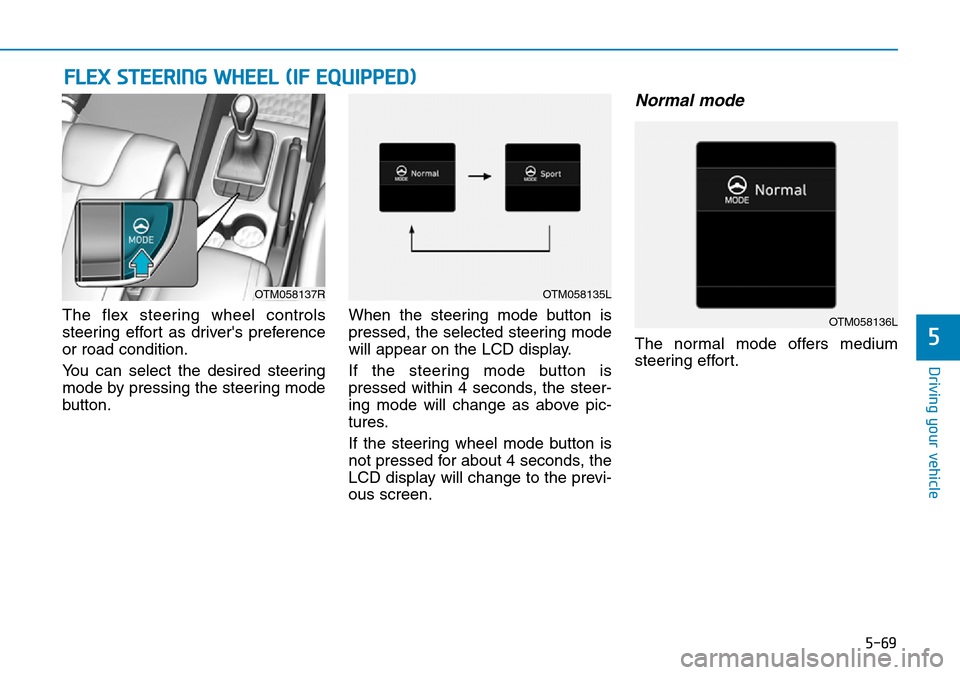
5-69
Driving your vehicle
5
The flex steering wheel controls
steering effort as driver's preference
or road condition.
You can select the desired steering
mode by pressing the steering mode
button.When the steering mode button is
pressed, the selected steering mode
will appear on the LCD display.
If the steering mode button is
pressed within 4 seconds, the steer-
ing mode will change as above pic-
tures.
If the steering wheel mode button is
not pressed for about 4 seconds, the
LCD display will change to the previ-
ous screen.
Normal mode
The normal mode offers medium
steering effort.
FLEX STEERING WHEEL (IF EQUIPPED)
OTM058137ROTM058135L
OTM058136L
Page 399 of 682
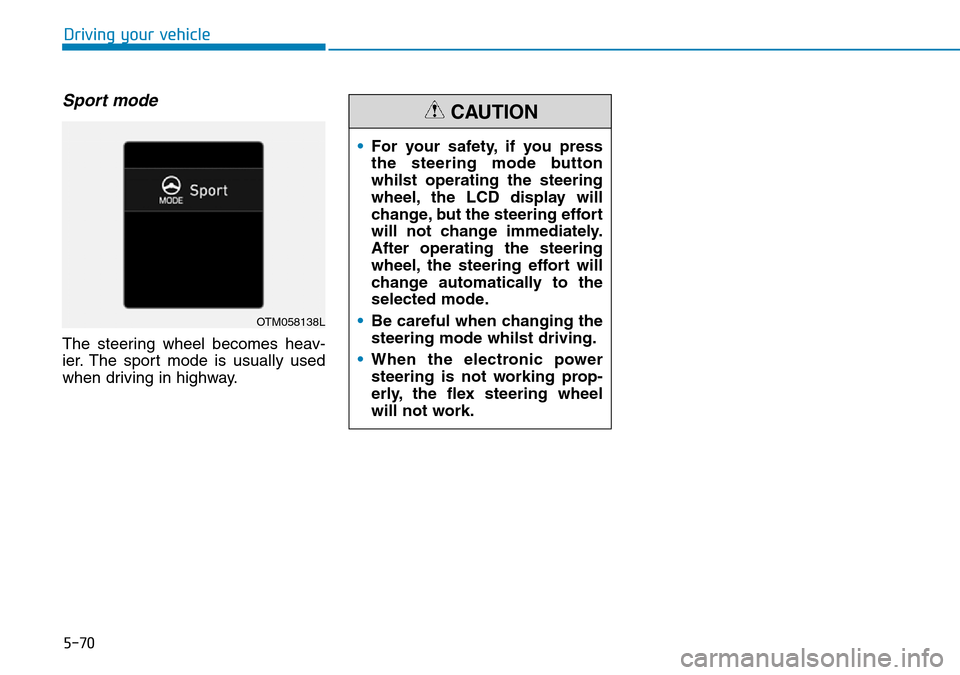
5-70
Driving your vehicle
Sport mode
The steering wheel becomes heav-
ier. The sport mode is usually used
when driving in highway.
OTM058138L
•For your safety, if you press
the steering mode button
whilst operating the steering
wheel, the LCD display will
change, but the steering effort
will not change immediately.
After operating the steering
wheel, the steering effort will
change automatically to the
selected mode.
•Be careful when changing the
steering mode whilst driving.
•When the electronic power
steering is not working prop-
erly, the flex steering wheel
will not work.
CAUTION
Page 400 of 682
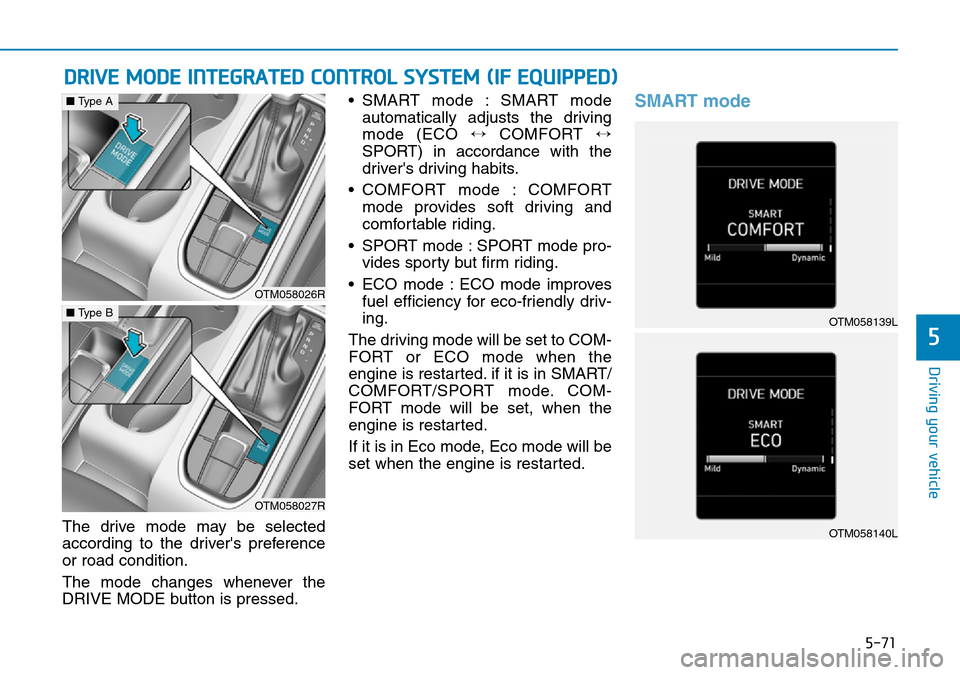
5-71
Driving your vehicle
5
DRIVE MODE INTEGRATED CONTROL SYSTEM (IF EQUIPPED)
The drive mode may be selected
according to the driver's preference
or road condition.
The mode changes whenever the
DRIVE MODE button is pressed.• SMART mode : SMART mode
automatically adjusts the driving
mode (ECO ↔ COMFORT ↔
SPORT) in accordance with the
driver's driving habits.
• COMFORT mode : COMFORT
mode provides soft driving and
comfortable riding.
• SPORT mode : SPORT mode pro-
vides sporty but firm riding.
• ECO mode : ECO mode improves
fuel efficiency for eco-friendly driv-
ing.
The driving mode will be set to COM-
FORT or ECO mode when the
engine is restarted. if it is in SMART/
COMFORT/SPORT mode. COM-
FORT mode will be set, when the
engine is restarted.
If it is in Eco mode, Eco mode will be
set when the engine is restarted.
SMART mode
OTM058026R
■Type A
OTM058027R
■Type BOTM058139L
OTM058140L